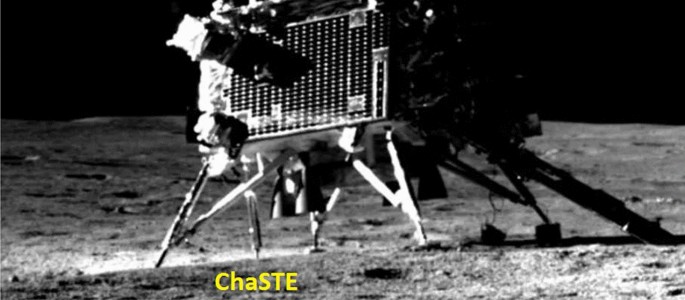Chandrayaan-3’s ChaSTE
Chandrayaan-3, India’s lunar exploration mission, successfully landed on the Moon’s south pole on 23 August 2023. Among its scientific instruments is the Chandra’s Surface Thermophysical Experiment (ChaSTE). This payload aims to investigate the Moon’s thermal properties, crucial for future exploration and understanding of lunar conditions.
Objectives
ChaSTE’s primary objectives include measuring the vertical temperature profile of the lunar regolith up to 100 mm deep. It also aims to assess thermal conductivity, which is essential for creating a comprehensive thermal profile of the Moon’s surface.
Design and Functionality
The ChaSTE probe is equipped with ten Platinum Resistance Temperature Detectors (RTD Pt-1000 sensors). These sensors are spaced at various depths along the probe. A ribbon heater near the probe’s tip allows for active thermal conductivity experiments. The probe is constructed from a composite material that minimises heat interference while ensuring mechanical strength.
Key Findings
ChaSTE provided the first in-situ temperature profile from the Moon’s south polar region. Surface temperatures reached up to 70°C during the lunar day, higher than expected. At a depth of 80 mm, temperatures dropped to around -10°C, indicating a steep thermal gradient.
Scientific Implications
The data gathered by ChaSTE enhances our understanding of solar heat interaction with the lunar surface. It also sheds light on the potential preservation of volatiles like water ice in permanently shadowed regions. These findings are vital for future lunar habitats and resource exploration.
Operational Details
ChaSTE was deployed on 24 August 2023 after the Vikram lander’s touchdown. The probe was driven into the regolith in steps, reaching a depth of 140 mm. Continuous temperature data was collected at one-second intervals for one lunar day, which lasts about 14 Earth days.
Significance of ChaSTE
ChaSTE’s groundbreaking data contrasts with previous lunar missions that focused on equatorial regions. The findings challenge existing thermal models and highlight the uniqueness of the Moon’s polar environment. This information is crucial for identifying stable subsurface locations for future exploration.
Historical Context
Previous attempts to deploy similar thermal probes on celestial bodies faced challenges. The European Space Agency’s Philae lander and NASA’s InSight mission encountered obstacles. ChaSTE’s innovative design, using a rotating mechanism for soil penetration, proved successful where others had failed.
Month: Current Affairs - April, 2025
Category: Science & Technology Current Affairs








